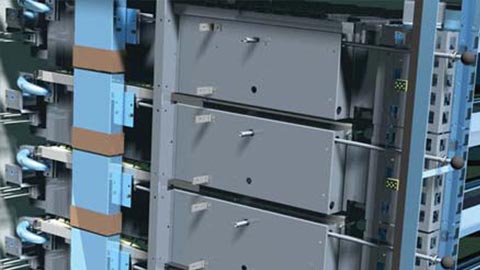Two highly successful fields of endeavor – one PLM environment
Two highly successful fields of endeavor – one PLM environment

Case Study
Two highly successful fields of endeavor – one PLM environment
Leutenegger + Frei
Solid Edge with synchronous technology enables design modifications to be made significantly faster and easier compared to prior method and other systems; company realizes tenfold improvement in design time turnaround
Two highly successful product lines
In business for more than 50 years, Leutenegger + Frei AG, based in Andwil, Switzerland, is a leader in electric bakery equipment, fermentation stopping installations and complete cooling systems. Product innovation, compelling aesthetic designs and high-quality production enable the company to regularly meet and exceed today’s market demands. For example, the freshness trend requires good-looking devices with smart functionality that can be permanently usable in bakeries and integrated bake-off-stations in combination with cold storage units. Such devices, while more expensive, represent an exceptional investment for the buyer. The devices provide superior aesthetics and productivity yet can be effectively amortized through energy efficiency, higher productivity and longevity.
In the mid 1970s, Leutenegger + Frei established a second, but equally successful line for industrial surface engineering, which involves applying appropriate treatments to the applicable components. Today, the company’s portfolio comprises cleaning and pre-treatment stations, paint finish and powder coating cabins as well as baking and enameling furnaces, which operate in combination with independent material handling systems. In paint shops all over Europe, Leutenegger + Frei’s single piece, task-specific designs provide the right brightness. To produce such equipment, the company faces completely different requirements than those faced in series or mass production. In this domain, comprehensive consulting is essential, with the result being installations according to very particular customer needs.
Nevertheless, like series production, the equipment must be designed and manufactured very efficiently. And such projects typically involve one or more new challenges. For example, an advanced system may require addressing extremely large assemblies and large-sized parts, complex materials handling and logistics during installation, and the assembly of hall-filling components, as well as overall project accountability including material handling systems and controls.
Changeover from 2D to 3D/2D
While diverse market opportunities are pursued by the company’s specialized sales teams, its engineering departments are organized for maximum flexibility. “By opening up our development and design, we secure knowledge and gain flexibility,” says Erich Leutenegger, managing director of the company. “Series production of bakery equipment ensures capacity utilization during times with fewer paintshop projects. Service efficiency benefits from more tasks in total. According to this strategy, a single CAD system should fit the divergent fields of application.”
In 2004, the company’s 2D system was causing a variety of concerns. Its effectiveness was being challenged, especially considering market advancements in 3D for product development. Management soon began examining the leading midrange systems, particularly in terms of the company’s unique needs. At Leutenegger + Frei, only a few engineers are involved in wholly new product design projects; most of them are detailing existing designs. Considering this, it only made sense that the new system be fully 2D compatible. “We knew that Solid Edge fulfilled this main specification best, as well as provided superior handling of imported data and large assemblies,” says Harry Lachauer, the company’s director of technology and production.
Not surprisingly, Solid Edge® software was selected as the company’s new CAD technology. Marco Petrillo, the company’s project director of Information Technology, points out, “We greatly facilitated the implementation by introducing process guidelines. We further demonstrated the company’s commitment to our new 3D technology with an investment in additional software licenses. The guidelines and the extension to more than 20 workplaces made a big difference to our users. Once the designers started experiencing the ease and power of Solid Edge, acceptance was imminent. More importantly, productivity increased significantly.”
